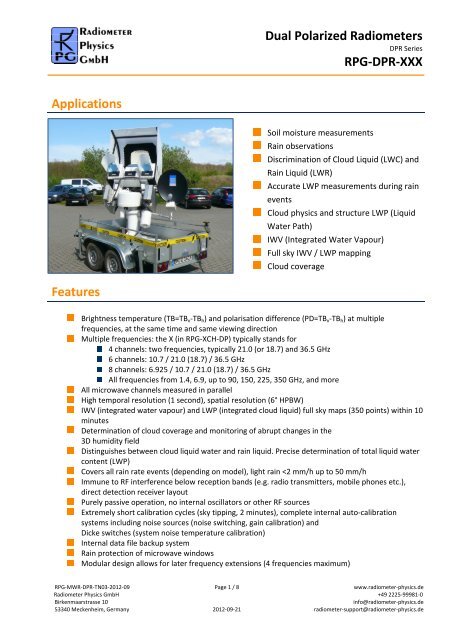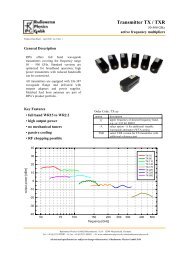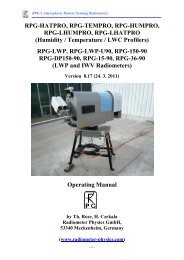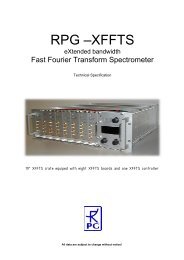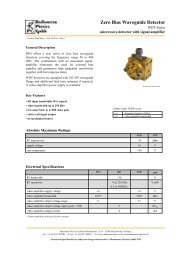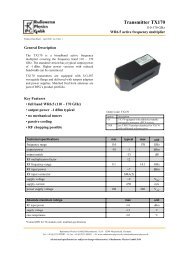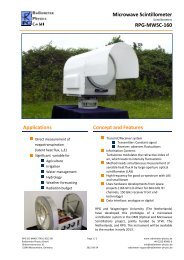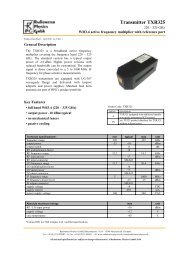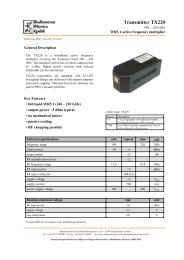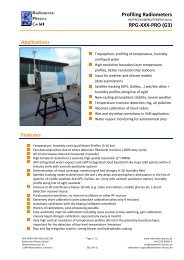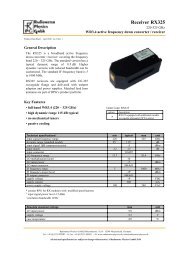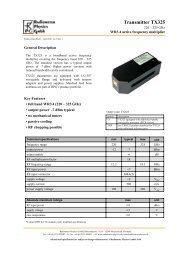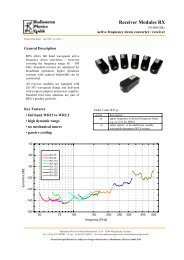on Dual-Polarization Radiometers - Radiometer Physics Gmbh
on Dual-Polarization Radiometers - Radiometer Physics Gmbh
on Dual-Polarization Radiometers - Radiometer Physics Gmbh
You also want an ePaper? Increase the reach of your titles
YUMPU automatically turns print PDFs into web optimized ePapers that Google loves.
<strong>Dual</strong> Polarized <strong><strong>Radiometer</strong>s</strong>DPR SeriesRPG‐DPR‐XXXApplicati<strong>on</strong>sSoil moisture measurementsRain observati<strong>on</strong>sDiscriminati<strong>on</strong> of Cloud Liquid (LWC) andRain Liquid (LWR)Accurate LWP measurements during raineventsCloud physics and structure LWP (LiquidWater Path)IWV (Integrated Water Vapour)Full sky IWV / LWP mappingCloud coverageFeaturesBrightness temperature (TB=TB v ‐TB h ) and polarisati<strong>on</strong> difference (PD=TB v ‐TB h ) at multiplefrequencies, at the same time and same viewing directi<strong>on</strong>Multiple frequencies: the X (in RPG‐XCH‐DP) typically stands for4 channels: two frequencies, typically 21.0 (or 18.7) and 36.5 GHz6 channels: 10.7 / 21.0 (18.7) / 36.5 GHz8 channels: 6.925 / 10.7 / 21.0 (18.7) / 36.5 GHzAll frequencies from 1.4, 6.9, up to 90, 150, 225, 350 GHz, and moreAll microwave channels measured in parallelHigh temporal resoluti<strong>on</strong> (1 sec<strong>on</strong>d), spatial resoluti<strong>on</strong> (6° HPBW)IWV (integrated water vapour) and LWP (integrated cloud liquid) full sky maps (350 points) within 10minutesDeterminati<strong>on</strong> of cloud coverage and m<strong>on</strong>itoring of abrupt changes in the3D humidity fieldDistinguishes between cloud liquid water and rain liquid. Precise determinati<strong>on</strong> of total liquid waterc<strong>on</strong>tent (LWP)Covers all rain rate events (depending <strong>on</strong> model), light rain
<strong>Dual</strong> Polarized <strong><strong>Radiometer</strong>s</strong>DPR SeriesRPG‐DPR‐XXXIntroducti<strong>on</strong>The RPG‐XCH‐DP is a 2/3/4 frequency, dual polarisati<strong>on</strong> radiometer with direct detecti<strong>on</strong> receivers andcomplete auto‐calibrati<strong>on</strong> fr<strong>on</strong>tends. The system requires no external calibrati<strong>on</strong> targets and performs skytippings for absolute calibrati<strong>on</strong> purposes. The system is split into different frequency modules which aregrouped <strong>on</strong> top of a precisi<strong>on</strong> elevati<strong>on</strong> / azimuth positi<strong>on</strong>er. Therefore the antennas can reach every pointin the sky and complicated scanning schemes, including full sky LWP / IWV maps are possible.One of the key features is the measurement of polarisati<strong>on</strong> difference (PD) during rain events under e.g. 30°elevati<strong>on</strong> angle. Falling droplets are flattened due to the air resistance from below and nearly form anellipsoid with l<strong>on</strong>g axis al<strong>on</strong>g the horiz<strong>on</strong>tal directi<strong>on</strong>. Therefore the emissi<strong>on</strong> of falling droplets is morepr<strong>on</strong>ounced in the horiz<strong>on</strong>tal polarisati<strong>on</strong> compared to the vertical. This allows for the separati<strong>on</strong> of cloudliquid (perfectly round droplets, approx. 20 µm in diameter) and rain liquid. Without taking the polarisati<strong>on</strong>difference into account, a radiometer overestimates the total liquid water c<strong>on</strong>tent during rain by assumingthat the brightness temperature signal is all generated by small cloud droplets. The small cloud dropletsproduce a much lower sky temperature than the bigger rain droplets, even with the same amount of liquidwater. Therefore the rain droplet c<strong>on</strong>tributi<strong>on</strong> to the sky temperature is relatively large while theirc<strong>on</strong>tributi<strong>on</strong> to the total liquid is smaller.HighlightsZenith Sky Observati<strong>on</strong>sWhen observing the sky in zenith directi<strong>on</strong>, polarizati<strong>on</strong> splitting should be zero, even if clouds are passingthe field of view. Falling rain droplets are vertically flattened, but this cannot be seen in zenith directi<strong>on</strong>.36.5 GHz (H/V)18.7 GHz (H/V)Fig. 1 Brightness Temperature time series (two frequencies, dual polarizati<strong>on</strong>).RPG‐MWR‐DPR‐TN03‐2012‐09 Page 2 / 8 www.radiometer‐physics.de<strong>Radiometer</strong> <strong>Physics</strong> GmbH +49 2225‐99981‐0Birkenmaarstrasse 10info@radiometer‐physics.de53340 Meckenheim, Germany 2012‐09‐21 radiometer‐support@radiometer‐physics.de
<strong>Dual</strong> Polarized <strong><strong>Radiometer</strong>s</strong>DPR SeriesRPG‐DPR‐XXXFig. 2 Polarizati<strong>on</strong> difference (PD=TBv‐TBh) time series for clear sky.Polarizati<strong>on</strong> effects due to falling rain droplets have to be observed under lower elevati<strong>on</strong> angles (e.g. 30°).Therefore, by directing the radiometer to zenith, the polarizati<strong>on</strong> difference between V and H should vanish.Fig.1 shows the TBs observed for a cloudy atmosphere and Fig.2 is the polarizati<strong>on</strong> difference.Observati<strong>on</strong>s under Low Elevati<strong>on</strong> AnglesThe following measurements were performed at 30° elevati<strong>on</strong> angle, observing a raining atmosphere (rainrate 5mm/h). The polarizati<strong>on</strong> splitting is very obvious but immediately drops down to zero, when the rainpauses.As expected, the 36.5 GHz channels resp<strong>on</strong>d much more sensitively to the liquid water and the polarizati<strong>on</strong>difference is more exaggerated. The 36.5 GHz channels are used for light rain detecti<strong>on</strong> while the 18.7 GHzchannels cover the str<strong>on</strong>g rain events with rain rates above 20‐30 mm/h when the 36.5 GHz channels arestarting to saturate.Fig.3 shows the retrieval outputs for the Tb time series above. LWR is the liquid water c<strong>on</strong>tent of the raindroplets, LWC denotes the cloud liquid and LWP is the total liquid water amount. The three time series arec<strong>on</strong>sistent even though the three quantities have been derived by three independent retrieval algorithms,<strong>on</strong>e for each product.RPG‐MWR‐DPR‐TN03‐2012‐09 Page 3 / 8 www.radiometer‐physics.de<strong>Radiometer</strong> <strong>Physics</strong> GmbH +49 2225‐99981‐0Birkenmaarstrasse 10info@radiometer‐physics.de53340 Meckenheim, Germany 2012‐09‐21 radiometer‐support@radiometer‐physics.de
<strong>Dual</strong> Polarized <strong><strong>Radiometer</strong>s</strong>DPR SeriesRPG‐DPR‐XXXraining cloudsn<strong>on</strong> rainingFig. 5 Simple regressi<strong>on</strong> retrieval for rain and cloud fracti<strong>on</strong> of LWP.Fig. 6 RPG Double Polarizati<strong>on</strong> <strong>Radiometer</strong>RPG‐MWR‐DPR‐TN03‐2012‐09 Page 5 / 8 www.radiometer‐physics.de<strong>Radiometer</strong> <strong>Physics</strong> GmbH +49 2225‐99981‐0Birkenmaarstrasse 10info@radiometer‐physics.de53340 Meckenheim, Germany 2012‐09‐21 radiometer‐support@radiometer‐physics.de
<strong>Dual</strong> Polarized <strong><strong>Radiometer</strong>s</strong>DPR SeriesRPG‐DPR‐XXXRPG‐MWR‐DPR‐TN03‐2012‐09 Page 6 / 8 www.radiometer‐physics.de<strong>Radiometer</strong> <strong>Physics</strong> GmbH +49 2225‐99981‐0Birkenmaarstrasse 10info@radiometer‐physics.de53340 Meckenheim, Germany 2012‐09‐21 radiometer‐support@radiometer‐physics.de
<strong>Dual</strong> Polarized <strong><strong>Radiometer</strong>s</strong>DPR SeriesRPG‐DPR‐XXXRPG‐MWR‐DPR‐TN03‐2012‐09 Page 7 / 8 www.radiometer‐physics.de<strong>Radiometer</strong> <strong>Physics</strong> GmbH +49 2225‐99981‐0Birkenmaarstrasse 10info@radiometer‐physics.de53340 Meckenheim, Germany 2012‐09‐21 radiometer‐support@radiometer‐physics.de
<strong>Dual</strong> Polarized <strong><strong>Radiometer</strong>s</strong>DPR SeriesRPG‐DPR‐XXXDetailed Instrument Specificati<strong>on</strong>sParameterSpecificati<strong>on</strong>System noise temperatures < 900 K typical for all receivers< 400 K below 60 GHz(including auto‐calibrati<strong>on</strong> fr<strong>on</strong>tend)Radiometric resoluti<strong>on</strong>0.15 RMS @ 1.0 sec integrati<strong>on</strong> timeChannel bandwidth400 MHz typ.Absolute system stability0.5 KRadiometric range0 – 400 KFrequencies 1.4, 6.9, 10.65, 18.7, 21.0, 23.8, 36.5, 37, 89, 90, 150Polarisati<strong>on</strong>2 linear polarizati<strong>on</strong>s (V / H) simultaneouslyAbsolute calibrati<strong>on</strong>with internal Dicke switch & external cold load, automaticsky tippingInternal calibrati<strong>on</strong>Gain: internal Dicke Switch + noise standardautomatic abs. cal.: sky tipping calibrati<strong>on</strong>Receiver and antenna thermal Accuracy < ±0.015 Kstabilizati<strong>on</strong>Gain n<strong>on</strong>linearity error correcti<strong>on</strong> Automatic, four point methodBrightness calculati<strong>on</strong>based <strong>on</strong> exact Planck radiati<strong>on</strong> lawIntegrati<strong>on</strong> time≥1 sec<strong>on</strong>d for each channelData interfaceRS‐232, 115 kBaudData rate9.5 kByte/s, RS‐232Instrument c<strong>on</strong>trolIndustrial PC, Pentium basedHousekeepingall system parameters, history documentati<strong>on</strong>Optical resoluti<strong>on</strong> HPBW: 6.1°Side‐lobe level


